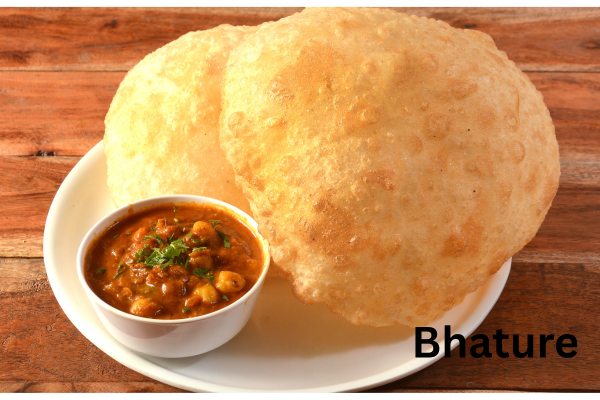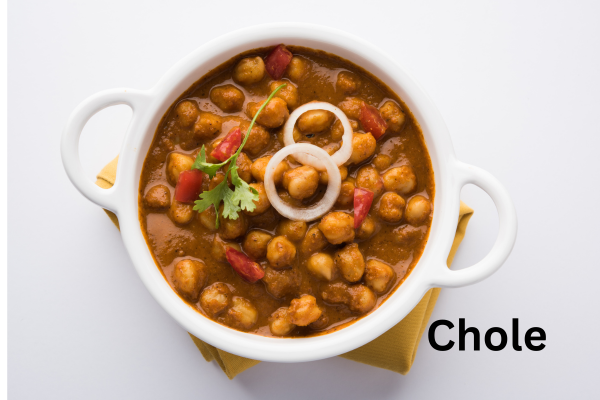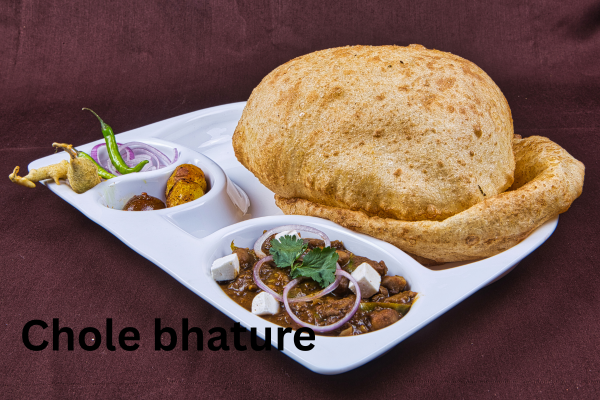A SHORT AUDIO OF THE POST
Introduction
One of the most famous and cherished dishes from North India is chole bhature, which is a combination of deep-fried, pillowy-soft bread (bhature) and spicy, tangy chickpeas (chole). Beyond its local roots, this traditional Punjabi dish has spread throughout India and is now a favorite in Indian eateries all over the world. The secret to making authentic Chole Bhature is striking the ideal balance: the bhature should be light, airy, and have a hint of crunch on the outside, while the chole should be deeply flavored and heavily spiced.
The Cultural Significance of Chole Bhature
It’s important to comprehend the dish’s cultural background before beginning the recipe. Chole Bhature, which originated in the Punjab region, was customarily made for Sunday breakfasts and special occasions. It gained popularity as a street food in North India over time, with minor regional variations added. Chole, for example, is a little sweeter in Delhi and more robust and spicy in Amritsar.
The popularity of the dish is due to its ideal balance of flavors and textures; the spices create a symphony of flavors that dance on the palate, while the softness of the bhature balances the hearty chickpeas. Because it is a full meal that fulfills the soul as well as the hunger, it has been a favorite for many generations.
Understanding the Key Components
To master authentic Chole Bhature, we must examine its two main components separately:
1. Bhature: The Perfect Fried Bread**
Bhature are not just simple fried bread – they’re an art form. The ideal bhatura should:
– Puff up like a balloon when fried
– Have a crisp exterior with a soft, slightly chewy interior
– Carry a subtle tang from fermentation
– Be light enough to not feel heavy after eating
The secret lies in the dough preparation, resting time, and frying technique – all of which we’ll cover in detail.

- Chole: More Than Just Chickpea Curry**
Authentic Punjabi chole is:
– Dark brown in color (not yellow or orange)
– Packed with layers of spices
– Slightly tangy from amla (dried gooseberries)
– Thick in consistency, not watery
– Balanced in heat, sweetness, and acidity
The cooking vessel (traditionally iron), the spice blend, and the cooking technique all contribute to achieving the perfect chole.

🧾 Detailed Ingredients Breakdown
Let’s examine each ingredient and its role in the recipe:
✅ Science Behind the Bhature Ingredients
- Maida (All-purpose flour): Provides the necessary gluten structure for puffing while keeping the texture light. Cake flour can work in a pinch but won’t give quite the same chew.
- Suji (Semolina): Adds slight crunch and helps absorb excess moisture, preventing sogginess. Fine sooji works best.
- Baking Soda: The alkaline environment helps with browning (Maillard reaction) and aids in the dough’s rise.
- Sugar:Feeds the yeast (from yogurt) during fermentation and promotes caramelization.
5.Ghee: Adds richness and flavor while tenderizing the gluten strands.
- Curd (Yogurt): Provides acidity for tenderizing and natural leavening from lactobacilli. Must be at room temperature.
7.Water: Hydration level is crucial – too little makes dense bhature, too much makes them greasy.
✅ The Chemistry of Perfect Chole
- Kabuli Chana: Larger, lighter-colored chickpeas preferred over the smaller kala chana for texture.
- Sukka Amla:Natural tannins help darken the chole and add a subtle sourness.
- Tea Powder:Polyphenols interact with iron to create that signature dark color.
- Iron Kadai:Iron ions react with tannins to deepen the color significantly more than stainless steel.
- Potatoes: Starch helps thicken the gravy naturally.
- Chole Masala: Typically contains pomegranate seeds, dried mango, and special spice blends.
👨🍳 Comprehensive Step-by-Step Recipe
🥖 Mastering Bhature: Technique Matters
- The Dough Development Stage
– Sift together dry ingredients to ensure even distribution
– Rub ghee into flour until it resembles breadcrumbs
– Add yogurt gradually while mixing
– Knead for 8-10 minutes to develop gluten
– The dough should be slightly tacky but not sticky
- Fermentation Process
– First rise: 2 hours at room temperature (25-30°C)
– Second rise: Overnight in fridge develops better flavor
– Dough should nearly double in volume
- Shaping and Frying
– Divide into 80-90g portions
– Roll to 1/4″ thickness – uneven thickness prevents proper puffing
– Oil temperature critical: 180-190°C
– Fry for 45-60 seconds per side, basting with hot oil
Common Bhature Problems & Solutions:
– Not puffing: Dough too thick, oil not hot enough
– Too dense: Over-kneaded or under-proofed
– Greasy: Oil temperature too low
🫘 The Art of Perfect Chole
- Advanced Soaking Technique
– Soak in warm water with 1 tsp baking soda for faster absorption
– Change water twice to reduce oligosaccharides (cause gas)
- Pressure Cooking Secrets
– Use 3:1 water to chickpea ratio
– Add 1 tbsp oil to prevent foaming
– Natural pressure release for tender chickpeas
- Building Flavor Layers
– Onion paste should cook until moisture evaporates
– Tomato puree must cook until oil separates
– Spices bloomed in oil release full flavor
- Final Simmering Tips
– Mash some chickpeas against pan wall to thicken
– Add cooking liquid gradually to control consistency
– Finish with kasuri methi for authentic aroma

🍽️ Professional Serving Suggestions
- Traditional Presentation:
– Serve in brass or copper bowls for authentic feel
– Garnish with julienned ginger and chaat masala
- Modern Twists:
– Chole stuffed bhature
– Mini bhature sliders
– Chole as a dip with bhature chips
- **Regional Variations:**
– Delhi style: Sweeter, with chana dal added
– Amritsari: Extra spicy with whole garam masala
– Mumbai: Pav instead of bhature
Love homemade comfort food? Explore these 5 irresistible snacks that you just can’t find outside your kitchen.
Frequently Asked Questions
- Can I make gluten-free bhature?
A mixture of 70% rice flour, 20% tapioca starch, and 10% psyllium husk can work, but it’s difficult. For binding, add xanthan gum. Although the texture will vary, it may be pleasing.
- How to achieve restaurant-style dark color without an iron kadai?
In half a cup of boiling water, steep two tablespoons of tea leaves, one amla, and one tablespoon of jaggery to make a “color potion.” While cooking, strain and add.
- Can I prepare components in advance?
– Dough: Up to 48 hours refrigerated
– Chole: Tastes better next day
– Fried bhature: Reheat in air fryer at 180°C for 3 minutes
- Do you have any expert advice for cooking in large quantities?
– Use a stand mixer with dough hook for large batches
– Maintain oil temperature with a thermometer
– Cook chole in batches no larger than 2 kg for even cooking
Final Thoughts: Mastering an Iconic Dish
Making authentic Chole Bhature introduces you to the rich culinary legacy of North India and offers a fulfilling culinary adventure. Despite the recipe’s numerous components, each one contributes to the creation of something greater than its individual parts. Keep in mind that even seasoned chefs improve their skills over time, so your fifth try will probably be better than your first.
The Perfect Pairing Science
Food science is necessary to comprehend why chole and bhature complement each other so well
- Chickpeas offer fiber and protein.
- Bhature provides quick carbs.
- The 15–20% fat content promotes fullness;
- Spices aid in digestion, and
- Acidic ingredients counterbalance the richness.
I suggest trying these related dishes if you want to broaden your Punjabi culinary repertoire:
– Amritsari Kulcha
– Rajma Chawal
– Makki di Roti and Sarson ka Saag
